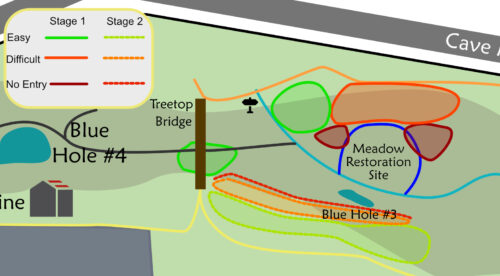A unique ecosystem is being created in a sunny glade in the woods at Lost River Cave.
Please see our Events Page for activities happening at the Meadow.
-
Meadow Restoration at Lost River Cave
Timeline for Meadow Restoration Actions in 2023
January: Mow to a height of 4 to 6 inches to knock back woody plant species, preferably when the soil is dry to minimize disturbance if at all possible.
February: Consider Aerial/Drone photography starting in winter and taking snapshots throughout the seasons/year. Establish Original Boundary of Meadow. Establish Flood Zone between February and May for annual seasonal rain events. Soil testing for Micronutrients and Heavy Metals.
March-June: Targeted removal of Rudbeckia triloba by hand. Will require identification of plant as rosette (1st year) and as mature plant (2nd year). Begins to flower in June. Recommend removal method to minimally disturb the soil so noxious seeds do not have the opportunity to germinate. Recommended Cover broadcast seeding to occur after each removal event of low/no cold stratification native plants with low potential to out-compete other established species.
April 15th: BioBlitz (noting if a list of species is present or absent in each divided section of the meadow) focused on early cool season species and spring ephemerals. Training will be scheduled. Keep an eye on our events page to sign up!
April 16 Delaney will lead a Wildflower Hike: Keep an eye on our events page to attend!
April Earth Day Week Event- (Up to LRC Staff/VIP Coordinator if the Meadow will be the focus of the event) Invasive Pull – Keep and eye on our events page to see how you can participate!

Map of invasive plant pull sites for Earth Week 2023 June 10 –: BioBlitz focused on early summer species. Training will be on site. Keep an eye on our events page to participate!
August 19th – BioBlitz 8-12 am. Keep and eye on our events page to participate!
September: Begin Assessment of Fall plans. Recommended (with current knowledge, subject to change):
- Survey of Rudbeckia Triloba removal effectiveness and whether efforts will need to be continued in species-specific removal.
- Set the Boundary for 4th year Meadow Growth.
- Seed Collection
- Species Assessment
- Begin planning for Winter and through early 2024
Previous Years Efforts
January 2020 – Planted bulbs and short grass meadow seed mix including:
- 6 Foam Flower Tiarella cordifolia
- 10 Bloodroot Sanguinaria canadensis
- 6 Jacob’s Ladder Polemonium reptans
- 5 Wild Geranium Geranium maculatum
- 10 Virginia Bluebells Mertensia virginica
- 5 Dutchman’s Breeches Dicentra cucullaria
- 5 Shooting Star Dodecatheon meadia
February 2020 – Continued efforts to eliminate invasive plants
May 2020 – Plants grown from seed by Kathee Morgeson along with plants ordered from two separate nurseries were palnted in the meadow
- 50 sedges (4 species) purchased from Ironweed Native Plant Nursery
- Kathee grew many plants from seed for planting in the meadow:
- 52 Purple Giant Hyssop – 6 species of bees, Great Spangled Fritillary, Peck’s skipper and Silver spotted skipper
- 26 Culver’s Root – host Culver’s Root Borer Moth, 7 species of bees + nectar
- 72 Cliff Goldenrod – nectar in fall
- 90 Great Blue Lobelia – 5 species of bees, nectar for butterflies and moths
- 36 Obedient Plant – 5 species of bees, nectar
- 7 Marsh Marigold – ants, many species of bees, cuckoo bees, and syrphid flies’ favorite
- 15 Fowl Manna – host Appalachian Brown, host Pepper and Salt Skippers
- 23 Little Bluestem
- 17 Hop Sedge
- 7 Cattail Sedge
- 49 Tall Bellflower
- 8 Sideoats Grama
- 23 Canada Wild Rye
- 15 Bottlebrush
- 3 trays(36 x 3) 108 Palm Sedge
- Plants from Prairie Moon Nursery:
- Phlox maculata – Wild Sweet William-6 Bare Root Plants
- Iris virginica var. shrevei – Southern Blue Flag-6 plants
- Lobelia siphilitica – Great Blue Lobelia -6 plants
- Eutrochium maculatum – Joe Pye Weed -6 plants
- Liatris ligulistylis – Meadow Blazing Star – 6 plants
- Lobelia cardinalis – Cardinal Flower – 7 plants
- Amsonia illustris – Ozark Bluestar – 7 plants
- Erythronium albidum – White Trout Lily – 5 Bare Roots
April 2022
- Invasive plants (mainly wintercreeper) was pulled from around the blue hole by Volunteers.
August 2022
- Brown eyed susan (Rudbeckia triloba) was removed from the meadow by volunteers. As a prolific re-seeder, this plant has been very successful in establishing itself in the meadow. In order to allow more space for a variety of native plants to thrive, volunteers hand pulled Rudbeckia triloba from the meadow while it was in bloom, making it easily identifiable.
